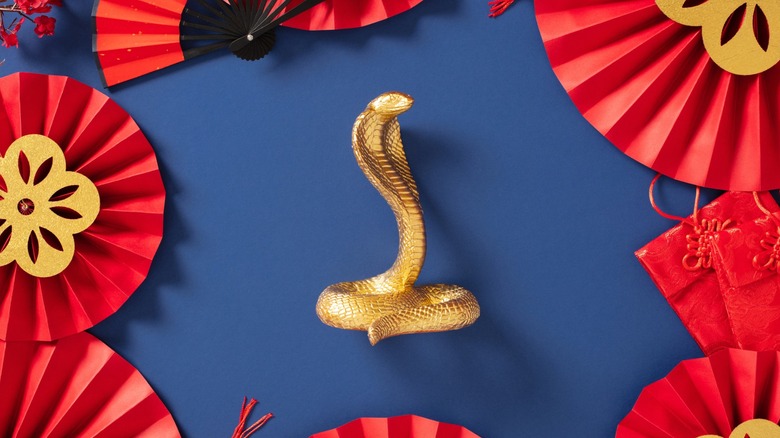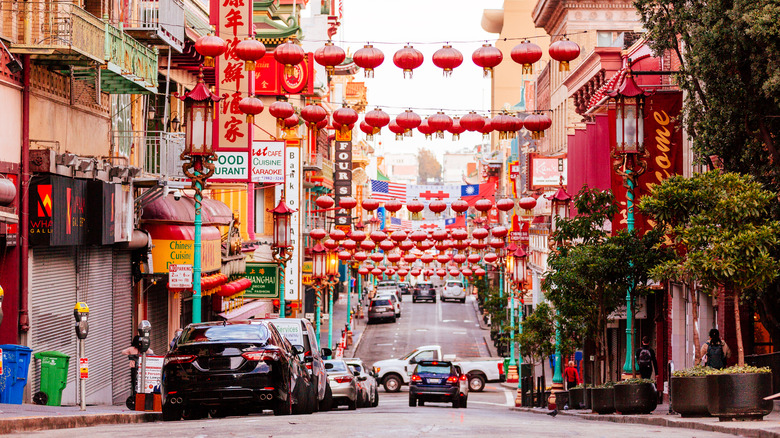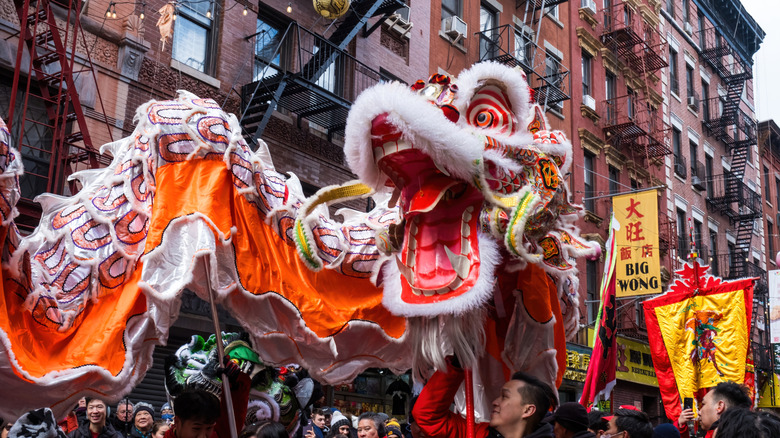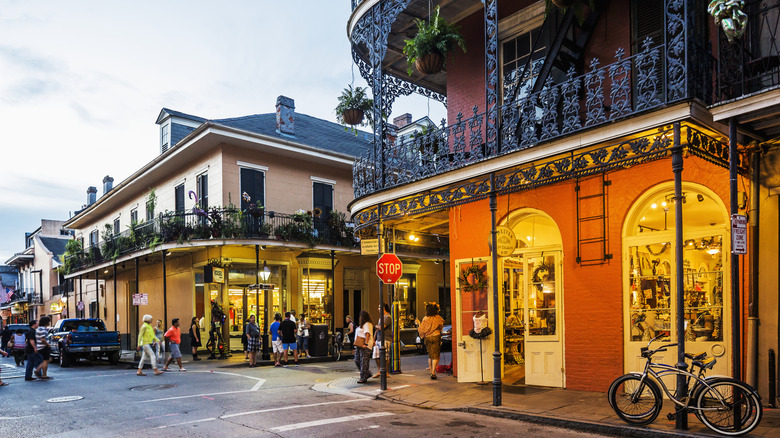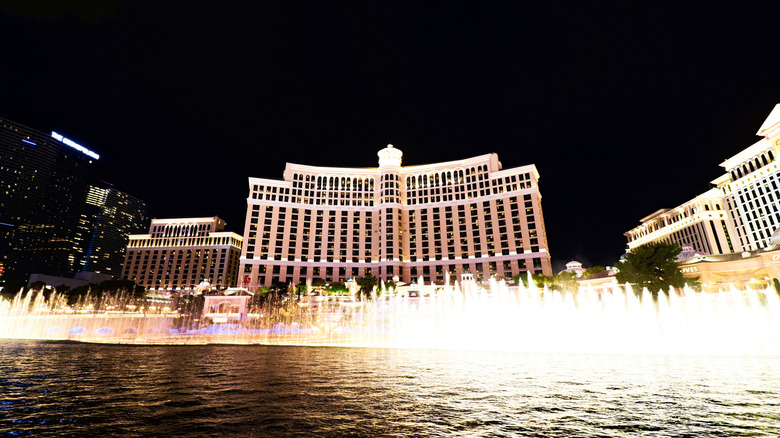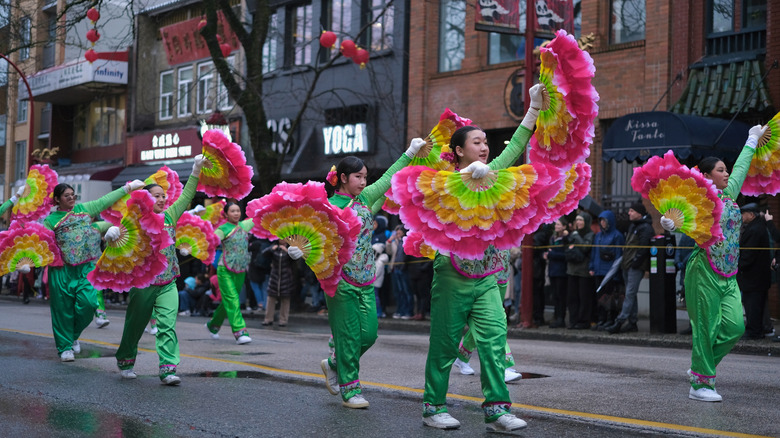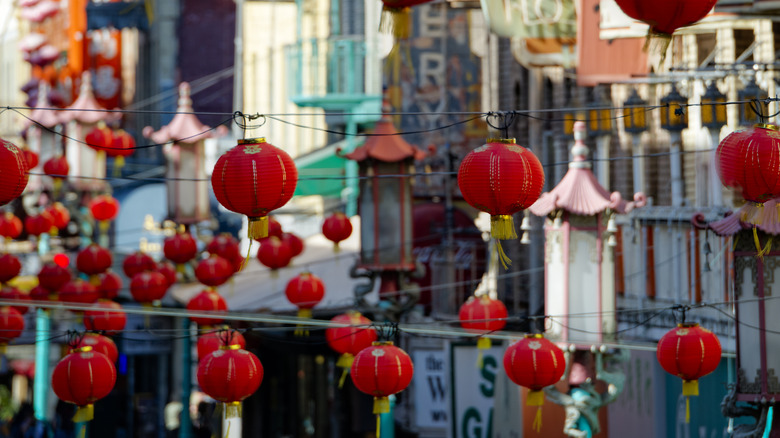The Most Festive American Chinatowns Celebrating The Year Of The Snake
The Lunar New Year is China's most significant holiday — and it's important to most other Asian cultures, too. Across North America, the Chinese and other communities who observe the lunar calendar celebrate it as a mega-holiday, like a combination of Thanksgiving, Christmas, and the New Year. This year, on January 29, tens of millions of Asian Americans of Chinese, Taiwanese, Vietnamese, and Korean descent will celebrate the start of the Year of Snake.
How did the animals come to represent different years? According to a Chinese folktale, the Jade Emperor, the ruler of the Heavens, deemed a systematic method of keeping track of time necessary. He invited the animals to join a race, and the first 12 animals to finish would determine the order of the years. The sneaky rat jumped on the back of the early-rising ox and finished the race first, followed by the ox. Then, the tiger, rabbit, dragon, snake, horse, goat, monkey, rooster, dog, and pig crossed the finish line and claimed their spots in the zodiac. If you have ever wondered why the cat is not in the lineup, the rat failed to wake the cat up for the race in its quest to eliminate a competitor. This is also why cats and rats remain mortal enemies.
Chinese culture honors the symbolic "Five Full" — no empty pockets, bowls, beds, stoves, and homes — during the New Year celebrations and practices rituals to ensure a year full of prosperity and happiness. Therefore, Chinatowns across America, from San Francisco to New York, New Orleans, Las Vegas, and Vancouver, throw blow-out parties and host massive parades. To ensure you find the best Lunar New Year celebrations across North America, we have consulted city governments, Asian-American Association websites, local news organizations, and travel bloggers.
San Francisco
In the 19th century, many Chinese from Guangzhou migrated to seek the so-called "Gold Mountain," which they believed to be in California, to seek their fortune working for the railroads or in the gold mines. They established the U.S.'s oldest Chinatown in their adopted homeland, where family-owned restaurants and small businesses remain the backbone of the community today. The first recorded Lunar New Year celebration in the U.S. was in the city in 1853. By the 1960s, the Chinese community had fused its traditional celebrations with the most iconic American practice: the parade. Since then, with the arrival of Koreans in the 1950s and '60s and Vietnamese in the 1970s, the Lunar New Year celebrations in San Francisco remain one of North America's grandest and most diverse.
San Francisco has a plethora of festive activities beginning a few days before the New Year. The Flower Market Fair begins the weekend before New Year's Day, January 25 and 26, and there you can purchase fresh flowers, fruits, candies, and other supplies needed for a fresh start to the year. On the day of the Lunar New Year, there will be an opening ceremony, followed by days of festivities, like a Basketball Jamobree and a Miss Chinatown USA Beauty Pagent. Then, the Chinese New Year Parade will take place on February 15 — and don't miss it. It's the most epic New Year bash outside of Asia, complete with amazing floats, roaring firecrackers, crazy acrobatics, and traditional performances including dancing and martial arts.
New York City
Although New York has only five boroughs, it has nine Chinatowns, making the Big Apple another hot spot for festivities. Established in the late 19th century by Cantonese-speaking immigrants, Manhattan's original Chinatown is now a tapestry of Asian communities famous for world-class restaurants and unique shopping experiences. It also hosts the annual Lunar New Year Parade and Festival, the centerpiece of the city's celebration. Don't miss the Firecracker Ceremony on the first day of the New Year, January 29, at Sarah D. Roosevelt Park — the crackling of firecrackers is a long-held Chinese tradition that wards off evil and misfortune at the start of every new year. The festival will also have artisan vendors, so you can indulge in Chinese street food while soaking in the joyous atmosphere. For a less rowdy celebration, get a ticket for the Lunar New Year Gala at the New York Philharmonic. Dress up fancy to bask in New Year vibes through grand orchestral numbers like Spring Festival Overture and Chinese Folk Dance Suite.
To learn more about Lunar New Year traditions, head to King Manor Museum in Queens for a free, family-friendly event the weekend before the first day of New Year. In addition to the parade of lion dancers and other traditional performances that rival the one in Manhattan, the Queen's Botanical Garden hosts an annual party filled with unique food and craft booths on February 8. Admission is free. Flushing, also known as "Little Taipei" or "Little Korea," is where a large Taiwanese and Korean population reside. The Glow Cultural Center in the neighborhood will host the Glow Snake Lunar New Year Celebration & Cultural Fair on February 2, with cultural booths, opera, and lion dancing.
New Orleans
With its substantial Vietnamese community, the Big Easy has a unique Lunar New Year celebration. In 1975, as Saigon fell under Communist rule, almost 2 million Vietnamese fled the country by boat. Some, attracted by Louisana's sub-tropical climate, proximity to water, and its French-Catholic roots, settled in New Orleans East and the West Bank. The 2,100 refugees that settled in the city have cherished their traditions while embracing their new homeland in the United States. Now, the community has grown to 14,000 strong, and they come together each Lunar New Year, known as Tết Nguyên Đán in Vietnamese. The community commemorates its culture's most significant holiday with Tet Fest at the Mary Queen of Vietnam Church.
Tet Fest is a charming showcase of Vietnamese heritage where everyone is welcomed. It's family-friendly, with dragon dance, traditional performances, and carnival games. Food takes center stage during this happy occasion. We can't think of a better way to rejoice than sipping on a steamy pho (rice noodles with a rich beef broth) and munching on grilled meats with fresh herbs. New Orleans' most iconic pastry, beignets, has also been adopted by the Vietnamese community to create delightful culinary fusions. You can't visit Tet Fest without sampling the fresh banana fritters and pandan waffles. If you need a little break from the festivities, meander on the Bayou Sauvage Trail to see the tranquil and scenic marshland. Also, don't forget to check out some of New Orleans' unmissable, fun activities — like cemetery tours and live shows on Frenchmen Street.
Las Vegas
Las Vegas, known for its grandeur and extravagance, is one of the most dazzling cities in the country to welcome the Year of the Snake. Not just known as the gambling capital, the City of Entertainment offers a wide range of fun shows. Vegas is the land of the awesome and quirky — from "Piano Man," Kyle Martin's Elton John and Billy Joel tribute show, to several stunning shows by Cirque du Soleil, be sure to check out Las Vegas' best-rated shows if you're in town for the Lunar New Year.
Though only 0.5% of Vegas' residents identified as Chinese in 1990, the community contributed greatly to the development of Vegas, from the first Chinese immigrant-owned laundromat in 1905 to the first legal Chinese immigrant-owned casinos in the 1930s and the first Chinese American showgirl in the 1950s. According to the South China Morning Post, the Asian-American population of Las Vegas' Clark County swelled in recent years to well over 237,000 people.
Chinese New Year in the Desert hosts numerous festive events through venues across Las Vegas. February 1 is the kick-off of the glorious Las Vegas Spring Festival Parade, where you can enjoy fabulous floats, flashy costumes, and cultural performances. Head to Chinatown on Spring Mountain Road for a day of delicious Chinese street food and fun activities. For the ultimate selfie backdrop, head to the Bellagio Conservatory and Botanical Garden for the special Lunar New Year exhibition of a magical, nearly 14,000-square-foot display of foliage. The iconic Venetian Resort is another must-visit, where you can see jubilant decorations, fireworks, and a lion dance. You can also try your New Year's luck at the casino. The resort also has several Chinese restaurants — Mott 32, Hong Kong Café, and Noodle Asia — offering tantalizing New Year dishes.
Vancouver
The Canadian city of Vancouver is famed for its natural beauty as well as its historic neighborhoods and trendy shops. Like San Francisco in the 1850s, many Chinese arrived in the Fraser Valley of British Columbia in search of gold. Now, representing over 11% of British Columbia's population, the second-largest Chinese community in Canada lives there. Therefore, British Columbians take their Lunar New Year festivities very seriously.
The annual LunarFest began during the Winter 2010 Olympics to showcase one of the oldest traditions celebrated by many Asian societies. Through collaborations with businesses and schools, LunarFest uses artistic expressions as an outreach to bring visibility to Asian culture. A pop-up artist market with the theme "Fluidity with Diversity" will happen on scenic Granville Island on the first two days of February, offering creative handmade items that reflect Asian culture or represent new beginnings and choices. The Lantern City hosts various exhibitions on the theme throughout the city that highlight the works of Asian and indigenous Canadians. Besides the annual Spring Festival Parade, Vancouver's Chinatown will host Taste of Chinatown!, featuring unique culinary experiences, such as pop-up collaborations with various restaurants, special tastings of new products, and artistic workshops to celebrate the Year of the Snake.
How we selected the cities
With a Chinatown in nearly every city across North America, we selected the five most festive Chinatowns based on their intriguing historical context, diversity of activities, size of the celebration, and notable attractions. In addition, our goal was to feature destinations with a strong local influence and cities that include non-Chinese-speaking communities to reflect the diversity of Lunar New Year cultural practices. While we couldn't visit each location personally, we relied on government websites, bloggers, local tourism companies, and news reporting to pinpoint the most distinctive locations that are fun during the Lunar New Year and worthy of a visit beyond the holiday season.
